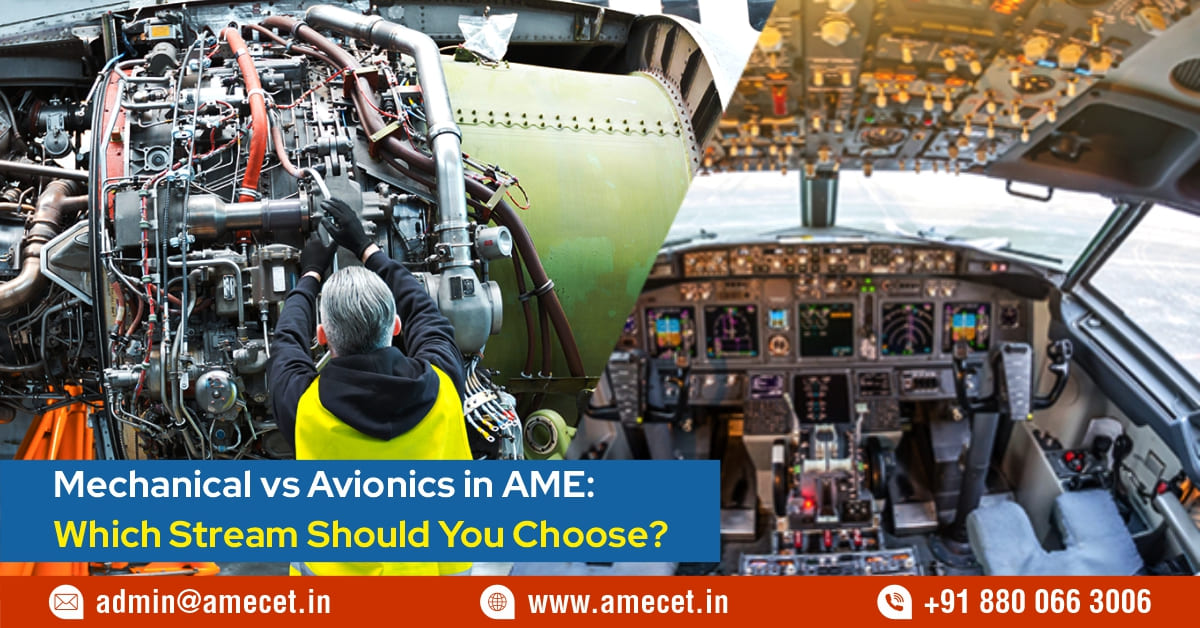Mechanical vs Avionics in AME: Which Stream Should You Choose?
Posted on : 22 August, 2025 1:59 pm
AME professionals are responsible for maintaining, repairing and overhauling aircraft, and ensuring that they are safe and airworthy. The course typically includes both theoretical and practical training, covering a wide range of topics related to aircraft systems, maintenance procedures, and regulations.
During the course, students can specialize in one of two streams-Mechanical (B1) or Avionics (B2). Choosing the right stream is an important decision, as it defines your career path in the aviation industry.
Overview of AME Streams
The AME course is usually divided into two parts:
- B1 (Mechanical Stream) – Focused on the aircraft’s body, systems, and engines.
- B2 (Avionics Stream) – Concentrates on electrical and electronic systems.
Both streams are licensed by aviation authorities such as DGCA, EASA, or FAA and are recognized worldwide.
Mechanical Stream (B1 License Category)
The mechanical stream deals with the physical structure and engines of aircraft.
- Subjects Covered – Aircraft structures, propulsion systems, hydraulics, pneumatics, fuel systems, and aerodynamics.
- Type of Work – Inspecting and repairing engines, landing gear, fuel systems, and airframes.
- Skills Required – Strong mechanical knowledge, hands-on maintenance ability, and troubleshooting skills.
- Career Opportunities – Jobs in airlines, MROs (Maintenance, Repair & Overhaul), and aircraft manufacturing companies.
This stream is ideal for students who are passionate about engines, machines, and physical systems.
Avionics Stream (B2 License Category)
The avionics stream is focused on the aircraft’s electrical and electronic systems.
- Subjects Covered – Electrical systems, avionics, instrumentation, communication, navigation, and digital techniques.
- Type of Work – Repairing wiring, electronic components, radar, GPS, and monitoring systems.
- Skills Required – Strong background in electronics, precision, and analytical problem-solving.
- Career Opportunities – Jobs in airlines, defense sectors, avionics companies, and aerospace technology firms.
This stream suits students who enjoy working with circuits, digital systems, and high-tech avionics equipment.
Key Differences between Mechanical and Avionics
| Aspect | Mechanical (B1 License) | Avionics (B2 License) |
| Nature of Work | Focuses on engines, airframes, and aircraft structures | Focuses on electrical, electronic, and avionics systems |
| Skillset | Requires mechanical aptitude, hands-on maintenance, and troubleshooting skills | Requires electronics knowledge, precision, and analytical problem-solving |
| Career Roles | Works with engines, landing gear, hydraulics, pneumatics, and fuel systems | Works with wiring, communication systems, navigation, radar, and instrumentation |
Which Stream Should You Choose?
When deciding between Mechanical and Avionics, consider:
- Interest – Do you prefer engines and systems (Mechanical) or electronics and digital systems (Avionics)?
- Career Goals – Both have strong job opportunities, but your long-term interest will guide your success.
- Industry Demand – Both streams are in high demand worldwide, ensuring stable and rewarding careers.
Both Avionics (B2) and Mechanical (B1) are extremely important for the aviation sector. It all depends on your interests, aptitude, and career goals. You can choose to work on engines or sophisticated avionics systems, but a career in AME promises great growth, stability, and the satisfaction of ensuring safe skies.

